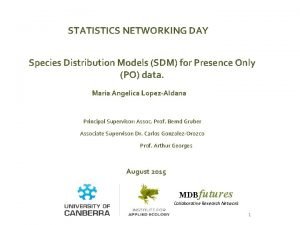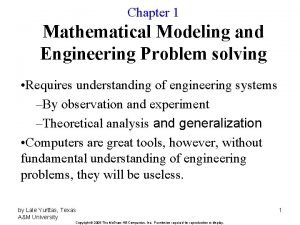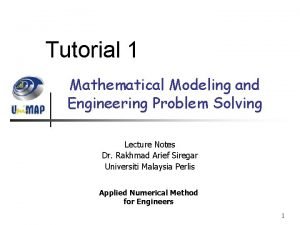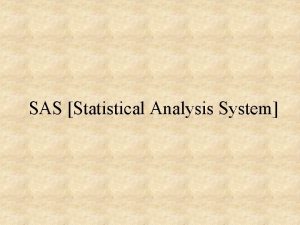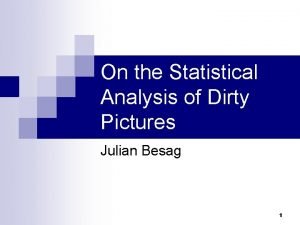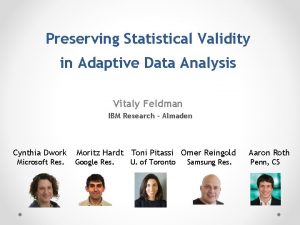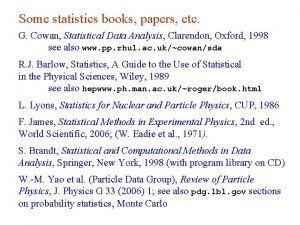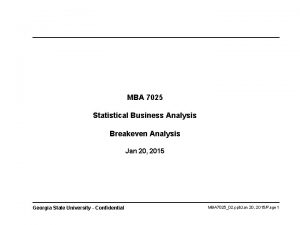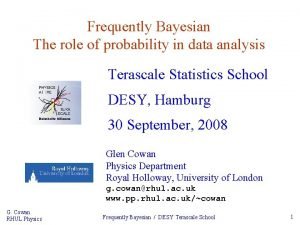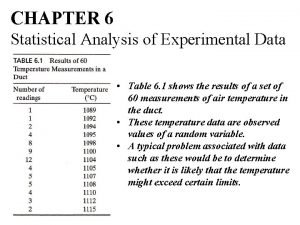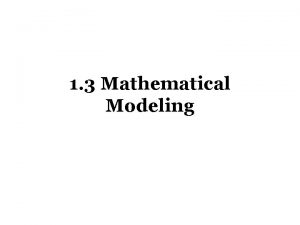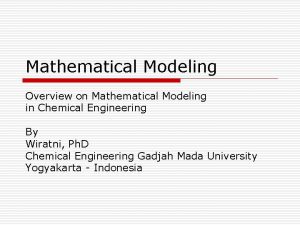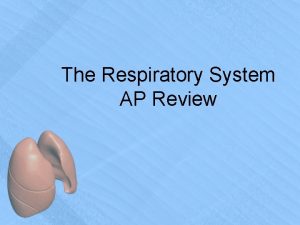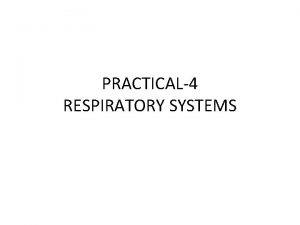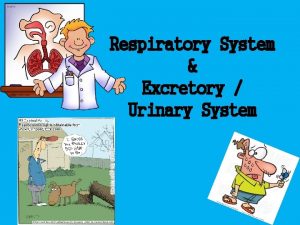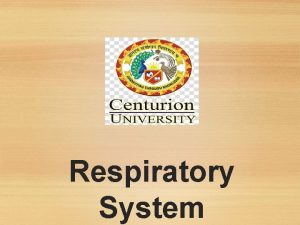From statistical analysis to mathematical system modeling Respiratory










![From statistical analysis to mathematical system modeling: Respiratory health in South Florida Q [W] From statistical analysis to mathematical system modeling: Respiratory health in South Florida Q [W]](https://slidetodoc.com/presentation_image_h/0c80ecbda83d7073e411f601e4055fdf/image-11.jpg)











- Slides: 22

From statistical analysis to mathematical system modeling: Respiratory health in South Florida D. Quesada 1, Y. Davila 1, 2, A. Perez 1, 3, and A. Alejo 1, 4 1 School of Science, Technology, and Engineering Management, St. Thomas University, Miami Gardens, FL 33054 2 Department of Mechanical Engineering, University of Colorado at Boulder, CO 3 Miami Dade County Public School System, Miami, FL 331 4 Miami Dade College, Wolfson Campus, Miami FL 331 Wolfram Technology Conference 2016, Urbana - Champaign

From statistical analysis to mathematical system modeling … Motivations Social and Personal • • Diagnosed with bronchial asthma as early as I was 9 years old. From age 9 to 15, multiple episodes of mild bronchial asthma in Cuba. No sign of asthma during my time in Russia despite of the extreme weather. Saving a co-worker in Cuba from a severe asthma collapse. She was almost dying. Very common condition among children, and elderly. Heavily impacted by urbanization and urban pollution. Cause # 1 of school absence in USA and many parts of the world. Systems Biophysics • • Understanding the molecular mechanisms behind asthma episodes. Understanding the integration of three systems through neuro – endocrine – immune interactions via Hypothalamic Pituitary Axis (HPA). Understanding the role of the branching network of the lung in the respiratory response during asthma episodes. Understanding the response of the human body to variations in weather conditions and exposure to different triggering agents: chemicals, pollens, and biogenic. Wolfram Technology Conference 2016, Urbana - Champaign

From statistical analysis to mathematical system modeling: Respiratory health in South Florida Content 1. Motivations. 2. Statistical Analysis using Mathematica packages for Time Series and Statistical Analysis. 3. Acclimatization Thermal Stress Index. 4. Upper Respiratory Tract Infections as triggers of asthma – Modeling approach using Mathematica solvers of ODE systems. 5. System Biology Approach – Neuro-endocrine -immune interactions. Modeling approach using Mathematica solvers of ODE systems. 6. Conclusions. Wolfram Technology Conference 2016, Urbana - Champaign

From statistical analysis to mathematical system modeling… Shift of the seasonality peak due to asthma at E. D. across the continental USA. Notice, how it moves from northern states to southern Florida. Air masses The peak coincides with the beginning of school year – school’s epidemics Spatial Synoptic Classification (SSC) – SC. Sheridan, Int. J. Climatol. 22, 51 – 68, (2002). The peak coincides with the end of fall term – school’s epidemics still? ? Aug - Sept - Oct - Nov Dec - Jan Wolfram Technology Conference 2016, Urbana - Champaign Time

From statistical analysis to mathematical system modeling … Number of asthma cases reported at Emergency Departments (ED) in Southeast Florida 2005 - 2012 BRACE project Building Resilience Against Climate Effects Wolfram Technology Conference 2016, Urbana - Champaign

From statistical analysis to mathematical system modeling … Miami Dade County time series smoothing and fitting and overall numbers per year Year Total Mean St. Dev. 2005 9686 26. 54 9. 27 2006 9591 26. 27 8. 84 2007 8122 22. 25 8. 51 2008 8763 23. 94 8. 30 2009 10293 28. 20 8. 39 2010 11373 31. 16 10. 80 2011 11219 30. 73 9. 18 Overall 69047 26. 54 Wolfram Technology Conference 2016, Urbana - Champaign

From statistical analysis to mathematical system modeling … Associations between the number of cases of asthma and weather parameters (temperature, diurnal range, net effective temperature) Why negative thermal loading is so relevant? • Keystone in the etiology of acute respiratory diseases. • Respiratory heat losses above the norm (15 W – effective heat loss) lead to high frequency of respiratory diseases in children. • High heat losses from respiratory organs make it easier for pathogenic micro-flora to penetrate the protective barrier of lungs and may be the reason for increased morbidity. Wolfram Technology Conference 2016, Urbana - Champaign

From statistical analysis to mathematical system modeling: Respiratory health in South Florida Net Effective Temperature (NET) P. W. Li and S. T. Chan, Meteorol. Appl. 7, 369 – 375 (2000) Wolfram Technology Conference 2016, Urbana - Champaign

From statistical analysis to mathematical system modeling: Respiratory health in South Florida Wolfram Technology Conference 2016, Urbana - Champaign

From statistical analysis to mathematical system modeling … Acclimatization Thermal Stress Index – Heat losses during respiration C. R. de Freitas, E. A. Grigorieva, Int. J. Biometeorol (2009) 53: 307 – 315 Q – heat exchanged during respiration • Daily refers to the heat exchange computed based on daily averages. • Normal refers to the heat exchange expected to happen according to climatological normal for a given area. Q = C + E Heat dissipated during respiration C = 1. 17 x 10 -3 M (Tcore – T) A E = 2. 3 x 10 -3 M (ea – es) A Convective Heat Exchange Evaporative Heat Exchange M – Metabolic heat rate == 90 W / m 2 person standing relaxed A – Du. Bois body area == 1. 8 m 2 Tcore – Body core temperature == 37 o. C T – ambient air temperature (o. C), or the Net Effective Temperature (o. C) es – saturated vapor pressure of ambient air (mm Hg) ea – saturated vapor pressure of core air == 44 mm Hg Magnus – Tetens approximation Wolfram Technology Conference 2016, Urbana - Champaign
![From statistical analysis to mathematical system modeling Respiratory health in South Florida Q W From statistical analysis to mathematical system modeling: Respiratory health in South Florida Q [W]](https://slidetodoc.com/presentation_image_h/0c80ecbda83d7073e411f601e4055fdf/image-11.jpg)
From statistical analysis to mathematical system modeling: Respiratory health in South Florida Q [W] 18 16 14 12 10 8 6 4 2 0 1 Qconv/Qeva 0. 4 0. 3 0. 2 (a) (b) 0. 1 0 2 3 4 5 6 7 Month 8 9 10 11 12 1 3 5 7 9 11 Computed heat losses Q including the convective and evaporative contributions (a) and their ratios (b). The curve in blue is obtained using only the mean temperature while the curve in red uses the net effective temperature. Notice the close to (above) threshold (15 W) values during winter months. Wolfram Technology Conference 2016, Urbana - Champaign

From statistical analysis to mathematical system modeling: Respiratory health in South Florida ATSI calculated using the Net Effective Temperature (Teffective) 70 50 30 10 -10 0 365 730 1095 1460 1825 2190 -30 -50 Wolfram Technology Conference 2016, Urbana - Champaign 2555

From statistical analysis to mathematical system modeling: Respiratory health in South Florida 35 30 25 20 15 10 5 0 Influenza Temperature Au gu Oc st to De be ce r m b Fe er br ua ry Ap ril Ju ne Temperature Centigrade Influenza per 10, 000 Eccles, R. (2002). An Explanation for the Seasonality of Acute Upper Respiratory Tract Viral Infections. Acta Otolaryngol, 183 -191. Respiratory Virus UPPER RESPIRATORY TRACT INFECTION Susceptibility to infection Mucociliary clearance Phagocytic activity Temp. of nasal epithelium Breathing Cold Air Wolfram Technology Conference 2016, Urbana - Champaign

From statistical analysis to mathematical system modeling: Respiratory health in South Florida S I R β(t) = β(0) (1 + Sin[2πt/T]) Seasonally forced infection rate Wolfram Technology Conference 2016, Urbana - Champaign

From statistical analysis to mathematical system modeling: Respiratory health in South Florida This plot represents the first model used, SIR (SSusceptible, I-Infected, R-Recovered) in which the infection rate (Beta) is periodic. This plot shows the result of the second model being SEIR, where the exposed (E) group was added to the system of differential equations. In this case the infection rate is periodic as well as the latency period of the infection in question. Wolfram Technology Conference 2016, Urbana - Champaign

From statistical analysis to mathematical system modeling … SEIAR model definition and solution S(t) – fraction of individuals who are susceptible. E(t) – fraction of individuals who are exposed. I(t) – fraction of individuals who are infected (showing clear signs). A(t) – fraction of individuals who are asymptomatic. R(t) – fraction of individuals who recovered. β(t) – transmission infection rate. μ(t) – latency rate. q – probability of becoming infected. (1 – q) – probability of becoming asymptomatic. p – probability that asymptomatic individuals are becoming infected. (1 – p) – probability that asymptomatic individuals recover. Wolfram Technology Conference 2016, Urbana - Champaign

From statistical analysis to mathematical system modeling: Respiratory health in South Florida In this case another group was added to the differential equation system, A for asymptomatic. The plot to the left contains the infection rate and latency period as constants, while the second one offers a more realistic representation, with both as variables. Quesada, D. ; Alejo, A. The seasonality of upper respiratory tract infections and their relationship to asthma. In Proceedings of the MOL 2 NET, International Conference on Multidisciplinary Sciences, 2016; Sciforum Electronic Conference Series, Vol. 2, 2016 , 07003; doi: 10. 3390/mol 2 net-02 -07003 Wolfram Technology Conference 2016, Urbana - Champaign

From statistical analysis to mathematical system modeling: Respiratory health in South Florida Wolfram Technology Conference 2016, Urbana - Champaign

Cold Dry Air + + Temperature of Airways (Conduction and Evaporation) + Osmolarity of lining fluid (Evaporation) + stimulatory -- inhibitory Upper Airway Receptors • Nasal • Oropharyngeal • Laryngeal + -- + + Pulmonary Receptors Bronchial Vaso-constriction And Post-cooling Hyperemia + + + Mucous Secretion + Epithelial Damage + + • • + + Secretory Cells • Mast Cells • Basophils • Eosinophils Mediators Histamine Prostaglandins Leukotrienes N. C. P. Vasodilation • Congestion Mucociliary Clearance + + Vascular Permeability + + + Airway Smooth Muscle Contraction Mucus + + + Airway Narrowing +

From statistical analysis to mathematical system modeling … Modeling Challenges 1. System of non linear ODEs (16 equations) with different time response for each subsystem. 2. The system is showing all types of states: stable, metastable, and unstable. Convergence between stable and metastable states sometimes is difficult to reach due to some stiffness in the equations involved (working on this difficulty) 3. Outcomes are of interest for applied mathematicians and complex systems physicists but in its current format, it is hard to translate to medical doctors. 4. Phase plots showing stable, metastable, and unstable states. Since the system is high dimensional, it seems to be more useful to introduce macroscopic indices condensing some of the variables and reducing the dimensions to only three. These new indices might be plotted using ternary diagrams and the results are expected to be in agreement with different asthma phenotypes. 5. PDE modeling of the air flow and temperature distribution in the upper and middle respiratory tract is needed – ideas on how to implement this on Mathematica are more than welcome. Wolfram Technology Conference 2016, Urbana - Champaign

From statistical analysis to mathematical system modeling … Conclusions 1. 2. 3. 4. Asthma is triggered indirectly by varying weather conditions. Weather conditions per se are not responsible for the episodes at ED. Weather conditions lead to evaporative losses within the upper and middle respiratory tract, which in turn, creates the favorable conditions for viruses to proliferate and to trigger inflammatory responses preceding asthma episodes. Upper respiratory tract infections asthma-triggered mechanism requires a periodic or a changing over time infection rate function. Otherwise, infections die quickly and inflammatory processes do not develop to the level able to trigger an asthma episode. Different phenotypes of asthma described in the medical literature seem to result from the competition of cells from the neuro-endocrineimmune systems. Wolfram Technology Conference 2016, Urbana - Champaign

From statistical analysis to mathematical system modeling … Final Remarks Acknowledgments For sponsoring the research an for supporting the attendance to conferences and workshops. BRACE project Building Resilience Against Climate Effects Yanko Davila, BS Mathematics University of Colorado, College of Engineering Boulder, CO For providing health data and networking. Ashley Perez, BS Mathematics Miami Dade Public Schools Aidin Alejo, REU intern from MDC. She is now at University of North Carolina, NC Wolfram Technology Conference 2016, Urbana - Champaign
 Conducting zone respiratory
Conducting zone respiratory Digestive system circulatory system and respiratory system
Digestive system circulatory system and respiratory system Sdm statistics
Sdm statistics Modeling and role modeling theory
Modeling and role modeling theory Relational modeling vs dimensional modeling
Relational modeling vs dimensional modeling Mathematical modeling of electrical systems
Mathematical modeling of electrical systems Mathematical modeling and engineering problem solving
Mathematical modeling and engineering problem solving Mathematical modeling and engineering problem solving
Mathematical modeling and engineering problem solving What is mathematical economics
What is mathematical economics Statistical analysis system
Statistical analysis system Dfd fragment
Dfd fragment Requirements modeling in system analysis and design
Requirements modeling in system analysis and design How respiratory system work with circulatory system
How respiratory system work with circulatory system Circulatory system and respiratory system work together
Circulatory system and respiratory system work together On the statistical analysis of dirty pictures
On the statistical analysis of dirty pictures Preserving statistical validity in adaptive data analysis
Preserving statistical validity in adaptive data analysis Multivariate statistical analysis
Multivariate statistical analysis Cowan statistical data analysis
Cowan statistical data analysis Statistical business analysis
Statistical business analysis Conjoint analysis software
Conjoint analysis software Cowan statistical data analysis pdf
Cowan statistical data analysis pdf Statistical analysis of experimental data
Statistical analysis of experimental data Simulation modeling and analysis law kelton
Simulation modeling and analysis law kelton


